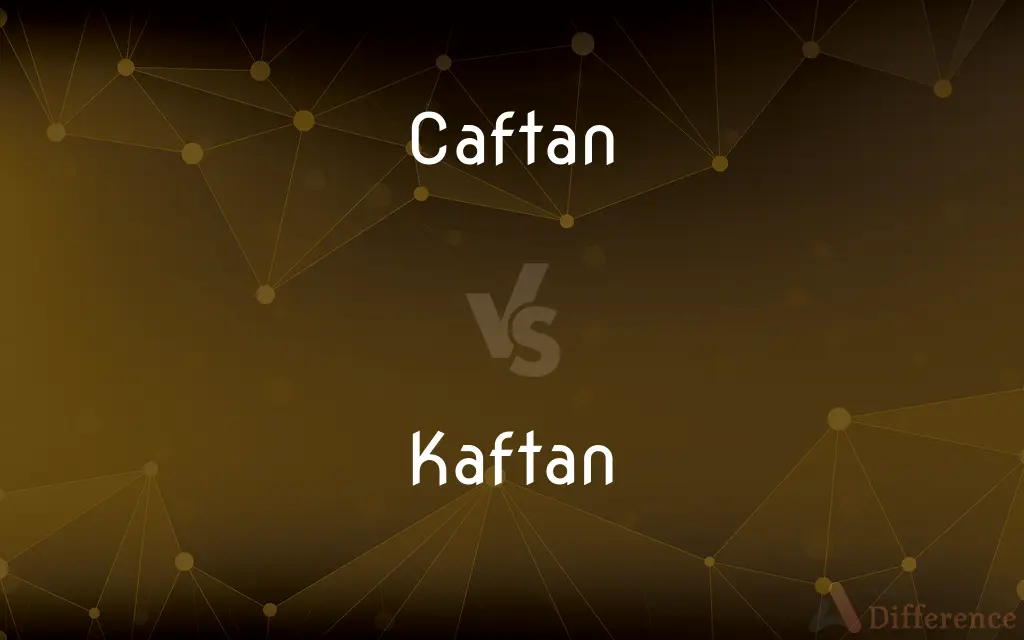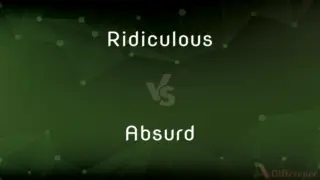Caftan vs. Kaftan — What's the Difference?
By Urooj Arif & Fiza Rafique — Updated on March 14, 2024
Caftan and kaftan refer to the same garment, a long, loose-fitting robe or tunic, with variations in spelling but no difference in meaning.

Difference Between Caftan and Kaftan
Table of Contents
ADVERTISEMENT
Key Differences
Both caftan and kaftan describe a type of long, flowing garment that originates from ancient Mesopotamia. This versatile piece of clothing has been adopted by various cultures around the world, with styles ranging from simple, everyday wear to elaborate, decorative versions for special occasions.
The spelling variations, caftan and kaftan, do not signify any difference in the garment itself but reflect the diverse linguistic influences and transliteration choices from Arabic and Persian into English and other European languages. While "kaftan" is more commonly used in British English, "caftan" tends to be favored in American English.
Caftans/kaftans are characterized by their loose fit, which provides comfort and airflow, making them suitable for a wide range of climates. They can be made from a variety of fabrics, including cotton, silk, and wool, and are often adorned with intricate patterns, embroidery, or embellishments.
In modern fashion, caftans/kaftans have been embraced for their elegance and versatility. They can be worn in both casual and formal settings, styled for beachwear, lounging at home, or even as sophisticated evening attire. The garment’s design allows for a high degree of customization in terms of length, material, and decorative features.
The popularity of caftans/kaftans transcends cultural boundaries, reflecting a global appreciation for their comfort, style, and adaptability. They continue to be a staple in both traditional and contemporary wardrobes, embodying a blend of cultural heritage and modern fashion sensibilities.
ADVERTISEMENT
Comparison Chart
Spelling Variations
Preferred in American and some European contexts
Common in British English and closer to Eastern origins
Origin
Ancient Mesopotamia, spreading to Middle East, North Africa, Southwest Asia
Same as caftan, with the name adapting to local languages
Usage
Interchangeable with kaftan, describing a long, flowing robe
Identical in meaning to caftan, denotes a traditional robe
Material
Can be made from silk, cotton, wool, among others
Same as caftan, varies with climate and occasion
Cultural Significance
Once a symbol of status; now worn widely for comfort and style
Similar cultural and social significance, with regional variations in style
Compare with Definitions
Caftan
A traditional long robe.
The bride wore an exquisite caftan made of silk and gold thread.
Kaftan
Indicative of cultural heritage.
Kaftans feature prominently in traditional ceremonies, showcasing rich embroidery.
Caftan
Adaptable to modern fashion.
Designers have reimagined the caftan for summer beachwear collections.
Kaftan
Reflects regional spelling preferences.
British designers often label their collections with kaftan instead of caftan.
Caftan
Comfort and elegance combined.
She chose a lightweight caftan for the garden party, valuing both style and comfort.
Kaftan
Integrates into contemporary styles.
The kaftan has been popularized as a versatile piece in casual wardrobes.
Caftan
Worn across various cultures.
In Morocco, the caftan is a staple garment for many festive occasions.
Kaftan
A loose-fitting traditional robe.
He donned a vibrant kaftan for the cultural festival.
Caftan
Symbol of status and wealth in history.
Historical figures often wore caftans crafted from luxurious fabrics.
Kaftan
Balances practicality with sophistication.
For her leisure at home, she prefers wearing silk kaftans for their ease and luxury.
Caftan
A full-length garment with elbow-length or long sleeves, worn chiefly in eastern Mediterranean countries.
Kaftan
A kaftan or caftan (; Persian: خفتان khaftān) is a variant of the robe or tunic, and has been worn in a number of cultures around the world for thousands of years and is of Asiatic origin. In Russian usage, kaftan instead refers to a style of men's long suit with tight sleeves.
Caftan
A westernized version of this garment consisting of a loose, usually brightly colored waist-length or ankle-length tunic.
Kaftan
A man's long belted tunic, worn in countries of the Near East.
Caftan
Alternative spelling of kaftan
Kaftan
Variant of caftan.
Caftan
A garment worn throughout the Levant, consisting of a long gown with sleeves reaching below the hands. It is generally fastened by a belt or sash.
Kaftan
A long tunic worn in the Eastern Mediterranean.
Caftan
To clothe with a caftan.
The turbaned and caftaned damsel.
Kaftan
A long dress or shirt similar in style to those worn in the Eastern Mediterranean.
Caftan
A woman's dress style that imitates the caftan cloaks worn by men in the Near East
Kaftan
See Caftan.
Caftan
A (cotton or silk) cloak with full sleeves and sash reaching down to the ankles; worn by men in the Levant
Kaftan
A woman's dress style that imitates the caftan cloaks worn by men in the Near East
Kaftan
A (cotton or silk) cloak with full sleeves and sash reaching down to the ankles; worn by men in the Levant
Common Curiosities
Are caftans and kaftans the same?
Yes, caftans and kaftans refer to the same type of garment, differing only in spelling.
Are caftans/kaftans only for formal occasions?
No, they are versatile garments worn for both casual and formal occasions.
Do caftans/kaftans come in one standard size?
No, they come in various sizes but are generally designed to be loose-fitting.
Can both men and women wear caftans/kaftans?
Yes, both men and women can wear caftans/kaftans, with styles varying across cultures.
Is there a difference in materials used for caftans and kaftans?
No, both garments can be made from the same variety of materials, including silk, cotton, and wool.
Can caftans/kaftans be worn in all seasons?
Yes, depending on the material, they can be adapted for all seasons.
Do the patterns on caftans/kaftans have specific meanings?
In some cultures, patterns can symbolize social status, marital status, or regional identities.
Are caftans/kaftans considered traditional or modern attire?
They are traditional garments that have been integrated into modern fashion.
How do I choose the right caftan/kaftan?
Consider the occasion, climate, material, and your personal style preferences when choosing.
Can caftans/kaftans be customized?
Yes, many designers and tailors can customize them to individual preferences.
Are there different styles of caftans/kaftans?
Yes, styles can vary widely, from simple, everyday wear to elaborate, ceremonial attire.
Is there a cultural significance to wearing a caftan or kaftan?
Yes, in many cultures, wearing a caftan or kaftan can signify respect for tradition and participation in cultural events.
How should a caftan/kaftan be cared for?
Care depends on the material, but generally, gentle washing and proper storage are recommended.
Can caftans/kaftans be worn with other clothing?
Yes, they can be layered over other clothing for added style or warmth.
Where can I buy a caftan or kaftan?
They are available in many clothing stores, online retailers, and at specialty boutiques.
Share Your Discovery

Previous Comparison
Ridiculous vs. Absurd
Next Comparison
Shaman vs. WizardAuthor Spotlight
Written by
Urooj ArifUrooj is a skilled content writer at Ask Difference, known for her exceptional ability to simplify complex topics into engaging and informative content. With a passion for research and a flair for clear, concise writing, she consistently delivers articles that resonate with our diverse audience.
Co-written by
Fiza RafiqueFiza Rafique is a skilled content writer at AskDifference.com, where she meticulously refines and enhances written pieces. Drawing from her vast editorial expertise, Fiza ensures clarity, accuracy, and precision in every article. Passionate about language, she continually seeks to elevate the quality of content for readers worldwide.















































